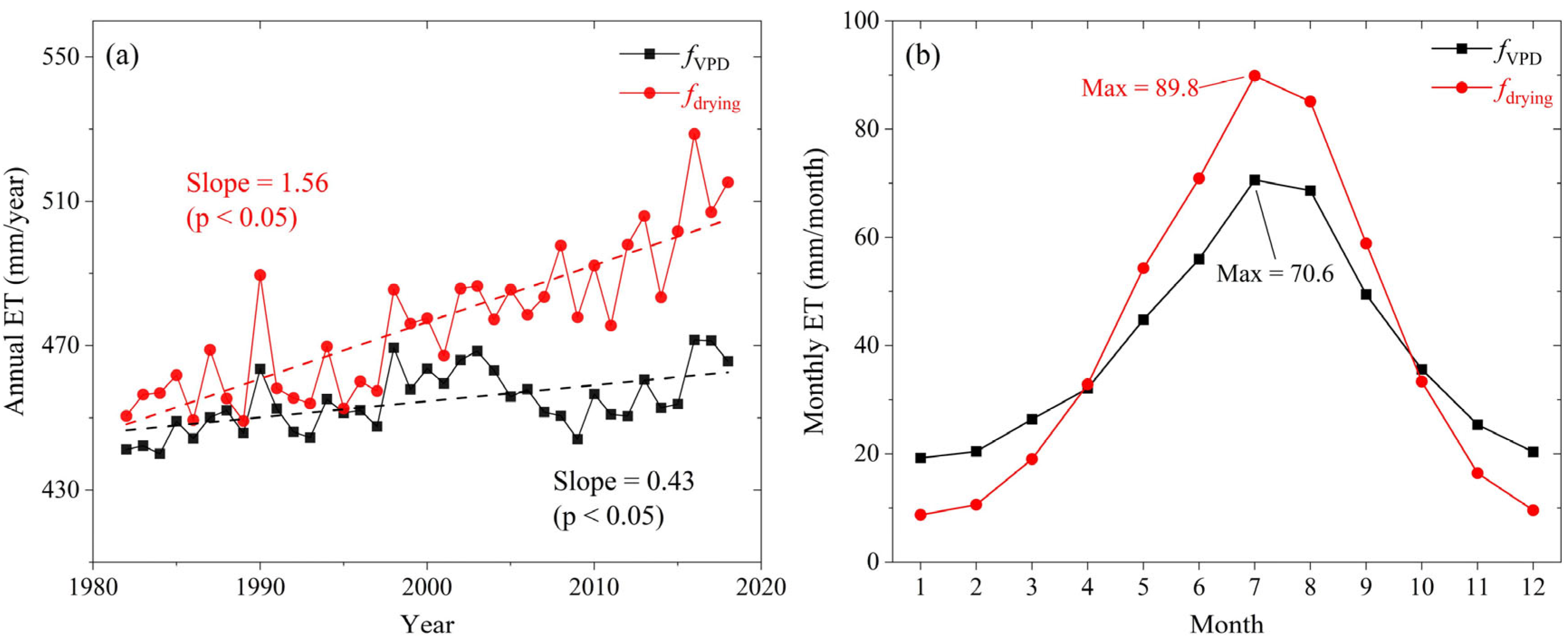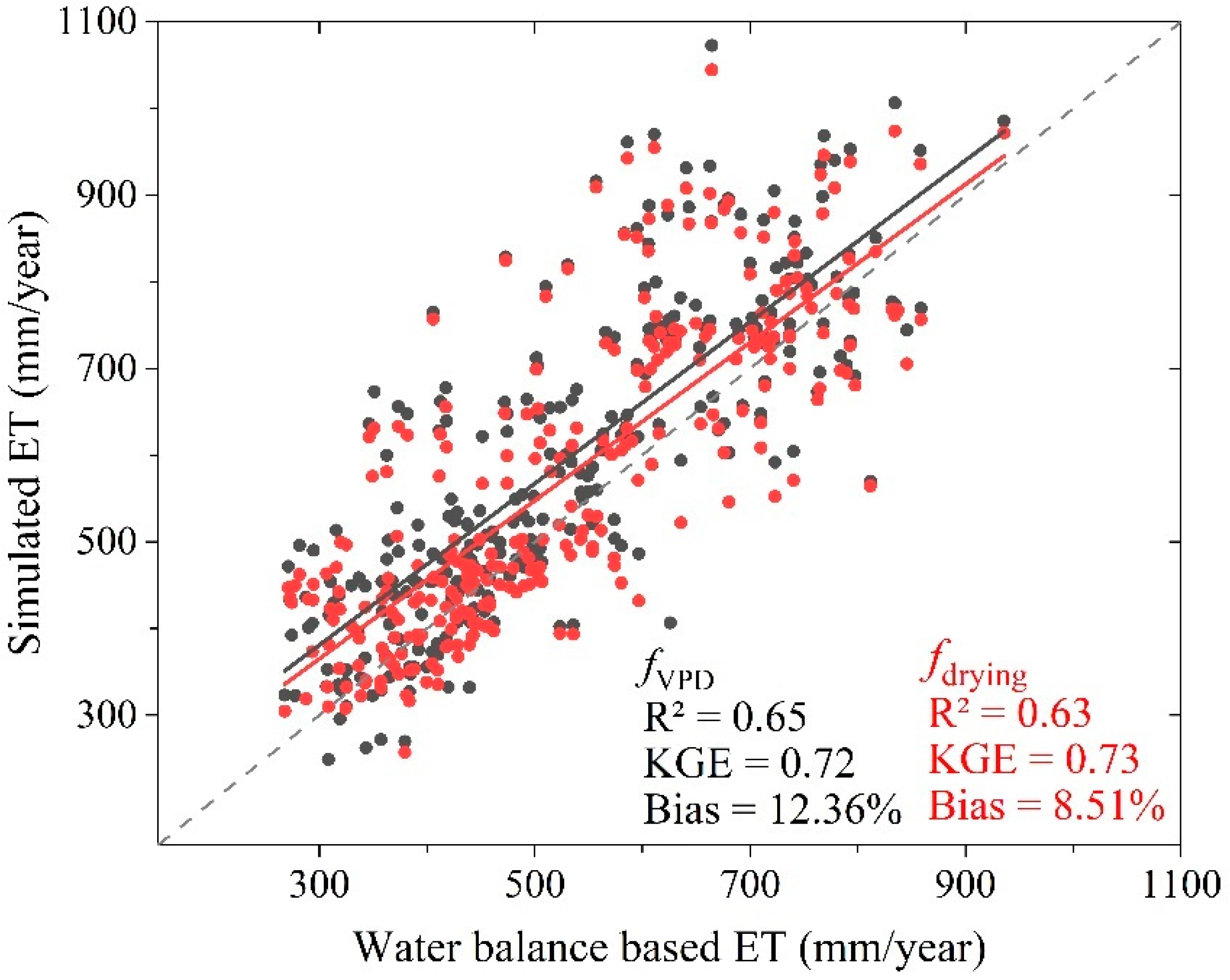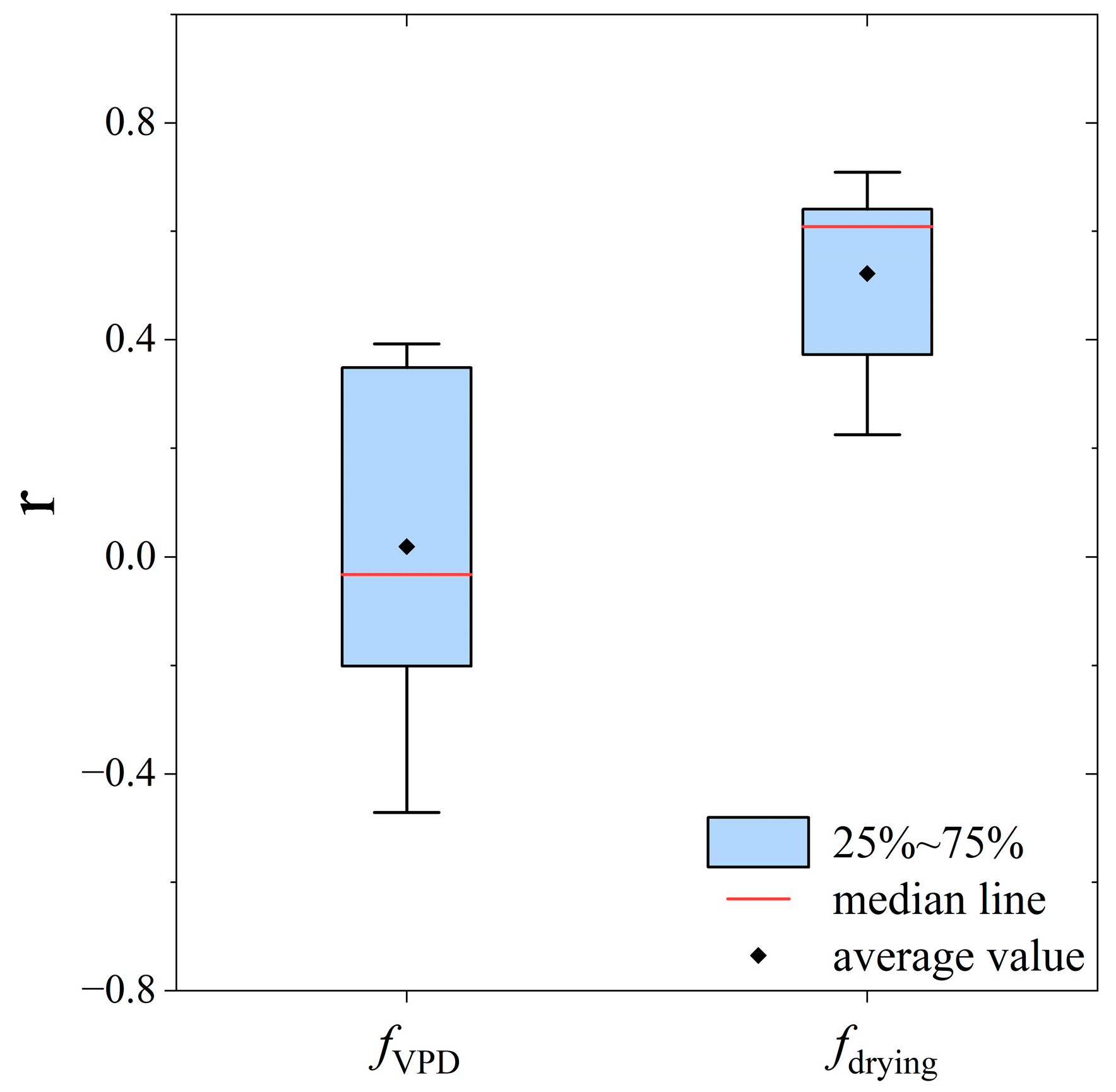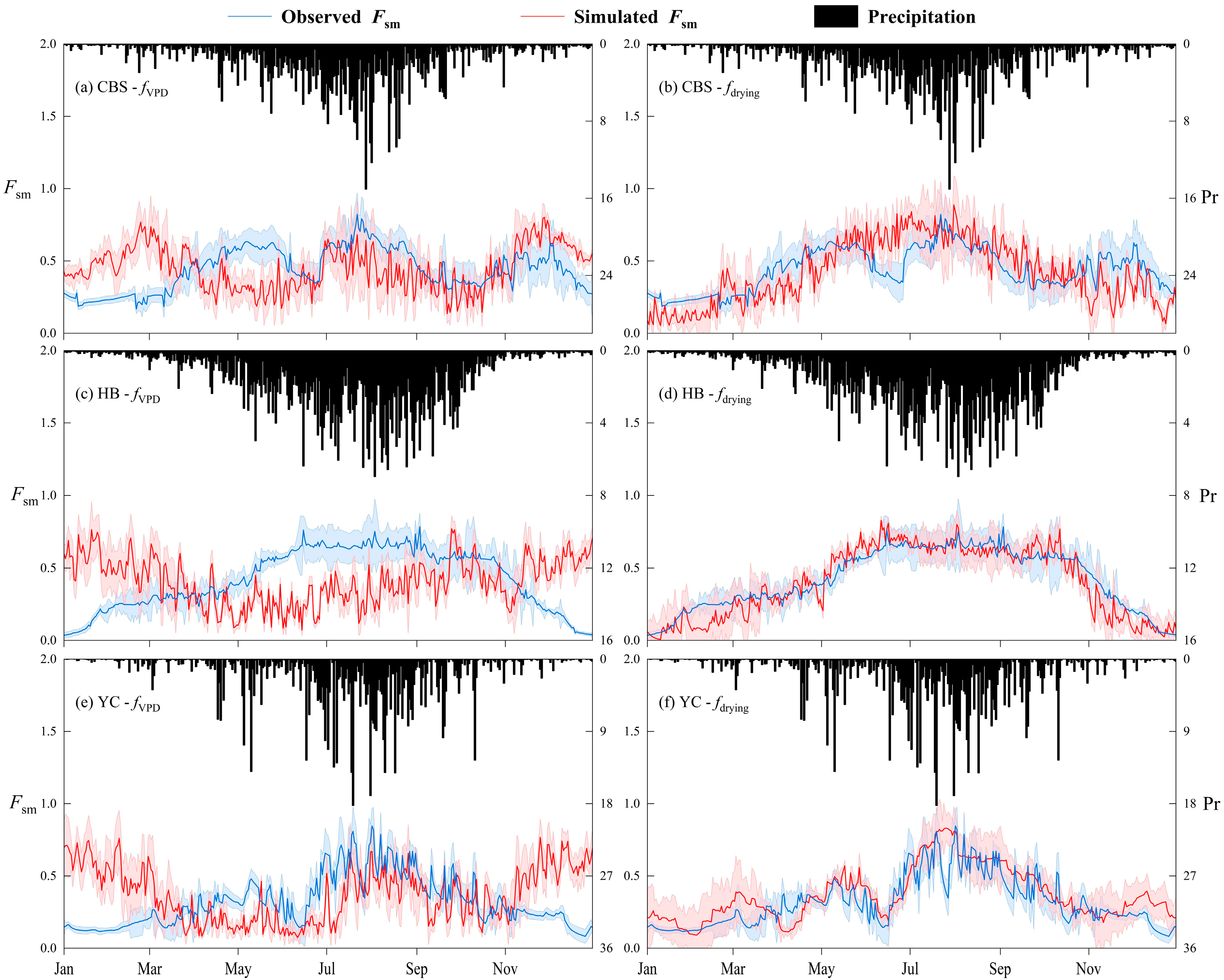The Modified Soil Moisture Constraint Scheme Significantly Enhances the Evapotranspiration Simulation Accuracy of the MOD16 Model
Abstract
:1. Introduction
2. Methodology and Data
2.1. Improvements on the MOD16 Algorithm
2.2. Data Sources and Processing
2.3. Model Performance Assessment
3. Results
3.1. The Spatiotemporal Feature of ET Estimates
3.2. ET Assessments on the Site and Basin Scales
3.3. Comparison of Different Soil Moisture Constraint Schemes
4. Discussion
4.1. Capacities of the Two Methods in Simulating the Soil Moisture Constraint (Fsm)
4.2. The Reason for the Improved Performance of the Modified Method over the MOD16 Model
4.3. Uncertainties
5. Conclusions
- (1)
- Introducing the modified soil moisture method to the MOD16 model increases the accuracy of ET estimations over the original MOD16 model on both the site and basin scale. Compared to the original model, the modified model increases the R2 value by an average of 0.16 and the KGE value by an average of 0.17 on the flux site scale. On the basin scale, the modified model increases the KGE value by an average of 0.01 and decreases the bias value by an average of 3.85% compared to the original model.
- (2)
- The modified method which considers the impact of precipitation has a better capacity to capture soil moisture variability than the original method. Compared to the original model, the modified model increases the correlation with observations by an average of 0.50 at all flux sites.
- (3)
- It is necessary to consider the impact in the variability of precipitation on soil moisture in the MOD16 model.
Author Contributions
Funding
Institutional Review Board Statement
Informed Consent Statement
Data Availability Statement
Conflicts of Interest
References
- Cheng, L.; Yang, M.; Wang, X.; Wan, G. Spatial and temporal variations of terrestrial evapotranspiration in the upper Taohe River Basin from 2001 to 2018 based on MOD16 ET data. Adv. Meteorol. 2020, 2020, 3721414. [Google Scholar] [CrossRef]
- Zhang, K.; Zhu, G.; Ma, J.; Yang, Y.; Shang, S.; Gu, C. Parameter analysis and estimates for the MODIS evapotranspiration algorithm and multiscale verification. Water Resour. Res. 2019, 55, 2211–2231. [Google Scholar] [CrossRef]
- Glenn, E.P.; Huete, A.R.; Nagler, P.L.; Hirschboeck, K.K.; Brown, P. Integrating remote sensing and ground methods to estimate evapotranspiration. Crit. Rev. Plant Sci. 2007, 26, 139–168. [Google Scholar] [CrossRef]
- Jung, M.; Reichstein, M.; Ciais, P.; Seneviratne, S.I.; Sheffield, J.; Goulden, M.L.; Bonan, G.; Cescatti, A.; Chen, J.; de Jeu, R.; et al. Recent decline in the global land evapotranspiration trend due to limited moisture supply. Nature 2010, 467, 951–954. [Google Scholar] [CrossRef]
- Hu, G.; Jia, L.; Menenti, M. Comparison of MOD16 and LSA-SAF MSG evapotranspiration products over Europe for 2011. Remote Sens. Environ. 2015, 156, 510–526. [Google Scholar] [CrossRef]
- Mu, Q.; Zhao, M.; Running, S.W. Improvements to a MODIS global terrestrial evapotranspiration algorithm. Remote Sens. Environ. 2011, 115, 1781–1800. [Google Scholar] [CrossRef]
- Chang, Y.; Qin, D.; Ding, Y.; Zhao, Q.; Zhang, S. A modified MOD16 algorithm to estimate evapotranspiration over alpine meadow on the Tibetan Plateau, China. J. Hydrol. 2018, 561, 16–30. [Google Scholar] [CrossRef]
- Luo, Z.; Guo, M.; Bai, P.; Li, J. Different Vegetation Information Inputs Significantly Affect the Evapotranspiration Simulations of the PT-JPL Model. Remote Sens. 2022, 14, 2573. [Google Scholar] [CrossRef]
- Gowda, P.H.; Howell, T.A.; Evett, S.R.; Chavez, J.L.; New, L. Remote sensing of contrasting tillage practices in the Texas Panhandle. Int. J. Remote Sens. 2008, 29, 3477–3487. [Google Scholar] [CrossRef]
- Liu, S.; Han, Y.; Su, H. Regional Evapotranspiration Estimation by the Improved MOD16-sm Model and Its Application in Central China. Water 2022, 14, 1491. [Google Scholar] [CrossRef]
- Sun, L.; Liang, S.; Yuan, W.; Chen, Z. Improving a Penman–Monteith evapotranspiration model by incorporating soil moisture control on soil evaporation in semiarid areas. Int. J. Digit. Earth 2013, 6, 134–156. [Google Scholar] [CrossRef]
- Di Bella, C.M.; Rebella, C.M.; Paruelo, J.M. Evapotranspiration estimates using NOAA AVHRR imagery in the Pampa region of Argentina. Int. J. Remote Sens. 2000, 21, 791–797. [Google Scholar] [CrossRef]
- Wang, K.; Liang, S. An improved method for estimating global evapotranspiration based on satellite determination of surface net radiation, vegetation index, temperature, and soil moisture. J. Hydrometeorol. 2008, 9, 712–727. [Google Scholar] [CrossRef]
- Su, Z. The Surface Energy Balance System (SEBS) for estimation of turbulent heat fluxes. Hydrol. Earth Syst. Sci. 2002, 6, 85–100. [Google Scholar] [CrossRef]
- Allen, R.G.; Tasumi, M.; Trezza, R. Satellite-based energy balance for mapping evapotranspiration with internalized calibration (METRIC)—Model. J. Irrig. Drain. Eng. 2007, 133, 380–394. [Google Scholar] [CrossRef]
- Priestley, C.H.B.; Taylor, R.J. On the assessment of surface heat flux and evaporation using large-scale parameters. Mon. Weather Rev. 1972, 100, 81–92. [Google Scholar] [CrossRef]
- Penman, H.L. Natural evaporation from open water, bare soil and grass. Proc. R. Soc. Lond. Ser. A Math. Phys. Sci. 1948, 193, 120–145. [Google Scholar]
- Monteith, J.L. Evaporation and environment. Symp. Soc. Exp. Biol. 1965, 19, 205–234. [Google Scholar]
- Tellen, V.A. A comparative analysis of reference evapotranspiration from the surface of rainfed grass in Yaounde, calculated by six empirical methods against the penman-monteith formula. Earth Perspect. 2017, 4, 4. [Google Scholar] [CrossRef]
- Mu, Q.; Heinsch, F.A.; Zhao, M.; Running, S.W. Development of a global evapotranspiration algorithm based on MODIS and global meteorology data. Remote Sens. Environ. 2007, 111, 519–536. [Google Scholar] [CrossRef]
- Zhang, T.; Chen, Y. Analysis of dynamic spatiotemporal changes in actual evapotranspiration and its associated factors in the Pearl River Basin based on MOD16. Water 2017, 9, 832. [Google Scholar] [CrossRef]
- Kim, H.W.; Hwang, K.; Mu, Q.; Lee, S.O.; Choi, M. Validation of MODIS 16 global terrestrial evapotranspiration products in various climates and land cover types in Asia. KSCE J. Civ. Eng. 2012, 16, 229–238. [Google Scholar] [CrossRef]
- Tang, R.; Shao, K.; Li, Z.-L.; Wu, H.; Tang, B.-H.; Zhou, G.; Zhang, L. Multiscale validation of the 8-day MOD16 evapotranspiration product using flux data collected in China. IEEE J. Sel. Top. Appl. Earth Obs. Remote Sens. 2015, 8, 1478–1486. [Google Scholar] [CrossRef]
- Di, S.-C.; Li, Z.-L.; Tang, R.; Wu, H.; Tang, B.-H.; Lu, J. Integrating two layers of soil moisture parameters into the MOD16 algorithm to improve evapotranspiration estimations. Int. J. Remote Sens. 2015, 36, 4953–4971. [Google Scholar] [CrossRef]
- Duan, H.; Zhao, H.; Li, Q.; Xu, H.; Han, C. Estimation of Evapotranspiration Based on a Modified Penman–Monteith–Leuning Model Using Surface and Root Zone Soil Moisture. Water 2023, 15, 1418. [Google Scholar] [CrossRef]
- Brust, C.; Kimball, J.S.; Maneta, M.P.; Jencso, K.; He, M.; Reichle, R.H. Using SMAP Level-4 soil moisture to constrain MOD16 evapotranspiration over the contiguous USA. Remote Sens. Environ. 2021, 255, 112277. [Google Scholar] [CrossRef]
- Noguera, I.; Vicente-Serrano, S.M.; Peña-Angulo, D.; Domínguez-Castro, F.; Juez, C.; Tomás-Burguera, M.; Lorenzo-Lacruz, J.; Azorin-Molina, C.; Halifa-Marín, A.; Fernández-Duque, B. Assessment of vapor pressure deficit variability and trends in Spain and possible connections with soil moisture. Atmos. Res. 2023, 285, 106666. [Google Scholar] [CrossRef]
- Novick, K.A.; Ficklin, D.L.; Stoy, P.C.; Williams, C.A.; Bohrer, G.; Oishi, A.C.; Papuga, S.A.; Blanken, P.D.; Noormets, A.; Sulman, B.N. The increasing importance of atmospheric demand for ecosystem water and carbon fluxes. Nat. Clim. Chang. 2016, 6, 1023–1027. [Google Scholar] [CrossRef]
- Fisher, J.B.; Tu, K.P.; Baldocchi, D.D. Global estimates of the land–atmosphere water flux based on monthly AVHRR and ISLSCP-II data, validated at 16 FLUXNET sites. Remote Sens. Environ. 2008, 112, 901–919. [Google Scholar] [CrossRef]
- Bouchet, R. Evapotranspiration reelle at potentielle, signification climatique. Int. Assoc. Sci. Hydrol. Pub. 1963, 62, 134–142. [Google Scholar]
- Running, S.W.; Mu, Q.; Zhao, M.; Moreno, A. MODIS Global Terrestrial Evapotranspiration (ET) Product (MOD16A2/A3 and Year-end Gap-Filled MOD16A2GF/A3GF) NASA Earth Observing System MODIS Land Algorithm (for Collection 6); National Aeronautics and Space Administration: Washington, DC, USA, 2019; Volume 6. [Google Scholar]
- Morillas, L.; Leuning, R.; Villagarcía, L.; García, M.; Serrano-Ortiz, P.; Domingo, F. Improving evapotranspiration estimates in Mediterranean drylands: The role of soil evaporation. Water Resour. Res. 2013, 49, 6572–6586. [Google Scholar] [CrossRef]
- Hutchinson, M.F.; Xu, T. Anusplin Version 4.2 User Guide. Centre for Resource Environmental Studies; The Australian National University: Canberra, Australia, 2004; Volume 5. [Google Scholar]
- Milewska, E.J.; Hopkinson, R.; Niitsoo, A. Evaluation of geo-referenced grids of 1961–1990 Canadian temperature and precipitation normals. Atmos.-Ocean 2005, 43, 49–75. [Google Scholar] [CrossRef]
- Qian, Y.L.; Lv, H.; Zhang, Y.H. Application and assessment of spatial interpolation method on daily meteorological elements based on ANUSPLIN software. J. Meteorol. Environ. 2010, 26, 7–15. [Google Scholar]
- Cai, F.; Yu, H.B.; Jiao, L.L.; Tang, K.; Ming, H.Q.; Liu, B. Comparison of precision of spatial interpolation of precipitation factors: A case study in northeastern China. Resour. Sci. 2006, 28, 73–79. [Google Scholar]
- Allen, R.; Pereira, L.; Raes, D.; Smith, M. FAO Irrigation and Drainage Paper No. 56; Food and Agriculture Organization of the United Nations: Rome, Italy, 1998. [Google Scholar]
- Bai, P.; Guo, X. Development of a 60-year high-resolution water body evaporation dataset in China. Agric. For. Meteorol. 2023, 334, 109428. [Google Scholar] [CrossRef]
- Senay, G.; Leake, S.; Nagler, P.; Artan, G.; Dickinson, J.; Cordova, J.; Glenn, E. Estimating basin scale evapotranspiration (ET) by water balance and remote sensing methods. Hydrol. Process. 2011, 25, 4037–4049. [Google Scholar] [CrossRef]
- Shi, C.; Jiang, L.; Zhang, T.; Xu, B.; Han, S. Status and plans of CMA land data assimilation system (CLDAS) project. Sci. China Earth Sci. 2014, 54, 1430–1440. [Google Scholar] [CrossRef]
- Qin, Y.; Wu, T.; Wu, X.; Li, R.; Xie, C.; Qiao, Y.; Hu, G.; Zhu, X.; Wang, W.; Shang, W. Assessment of reanalysis soil moisture products in the permafrost regions of the central of the Qinghai–Tibet Plateau. Hydrol. Process. 2017, 31, 4647–4659. [Google Scholar] [CrossRef]
- Krause, P.; Boyle, D.P.; Bäse, F. Comparison of different efficiency criteria for hydrological model assessment. Adv. Geosci. 2005, 5, 89–97. [Google Scholar] [CrossRef]
- Du, J.; Song, K. Validation of global evapotranspiration product (MOD16) using flux tower data from Panjin coastal wetland, Northeast China. Chin. Geogr. Sci. 2018, 28, 420–429. [Google Scholar] [CrossRef]
- Gupta, H.V.; Kling, H.; Yilmaz, K.K.; Martinez, G.F. Decomposition of the mean squared error and NSE performance criteria: Implications for improving hydrological modelling. J. Hydrol. 2009, 377, 80–91. [Google Scholar] [CrossRef]
- Knoben, W.J.M.; Freer, J.E.; Woods, R.A. Inherent benchmark or not? Comparing Nash–Sutcliffe and Kling–Gupta efficiency scores. Hydrol. Earth Syst. Sci. 2019, 23, 4323–4331. [Google Scholar] [CrossRef]
- Mauder, M.; Foken, T.; Cuxart, J. Surface-energy-balance closure over land: A review. Bound.-Layer Meteorol. 2020, 177, 395–426. [Google Scholar] [CrossRef]
- Foken, T.; Wimmer, F.; Mauder, M.; Thomas, C.; Liebethal, C. Some aspects of the energy balance closure problem. Atmos. Chem. Phys. 2006, 6, 4395–4402. [Google Scholar] [CrossRef]
- Bai, P.; Liu, X. Intercomparison and evaluation of three global high-resolution evapotranspiration products across China. J. Hydrol. 2018, 566, 743–755. [Google Scholar] [CrossRef]
- Liu, S.; Xu, Z.; Song, L.; Zhao, Q.; Ge, Y.; Xu, T.; Ma, Y.; Zhu, Z.; Jia, Z.; Zhang, F. Upscaling evapotranspiration measurements from multi-site to the satellite pixel scale over heterogeneous land surfaces. Agric. For. Meteorol. 2016, 230, 97–113. [Google Scholar] [CrossRef]







| Data Type | Data Name | Sources |
|---|---|---|
| Meteorological forcing data | Precipitation | https://data.cma.cn/ (accessed on 10 March 2023) |
| Temperature | ||
| Relative humidity | ||
| Sunshine duration | ||
| Wind speed | ||
| Land surface data | Albedo (0.05 degree) | http://www.glass.umd.edu/index.html (accessed on 20 May 2023) |
| LAI (0.05 degree) | http://www.glass.umd.edu/index.html (accessed on 20 May 2023) | |
| Land cover | https://lpdaac.usgs.gov/products/mcd12c1v006/ (accessed on 20 May 2023) | |
| Evaluation data | ET Flux and Soil moisture | http://www.chinaflux.org/ (accessed on 20 March 2023), https://fluxnet.org/data/fluxnet2015-dataset/ (accessed on 2 June 2023) http://data.tpdc.ac.cn/zh-hans/special/haihe/ (accessed on 2 June 2023) |
| River discharge | http://www.chinaflux.org/ (accessed on 25 May 2023) | |
| CLDAS | https://data.cma.cn/data/detail/dataCode/NAFP_CLDAS2.0_NRT.html (accessed on 12 April 2023) |
| Number | Station | Ecosystem Type | Elevation (m) | MAP (mm/year) | MAT (°C) | Time Range |
|---|---|---|---|---|---|---|
| F1 * | CBS | MF | 738 | 713 | 3.6 | 2003–2010 |
| F2 * | CYZ | ENF | 110 | 1542 | 17.9 | 2003–2010 |
| G1 * | NMG | GRA | 1200 | 338 | 0.9 | 2007–2010 |
| G2 * | DX | GRA | 4333 | 450 | 1.3 | 2004–2010 |
| G3 | DL | GRA | 1350 | 319 | 2.0 | 2006–2008 |
| G4 | CL | GRA | 171 | 315 | 7.5 | 2007–2010 |
| G5 * | HB | GRA | 3190 | 535 | −1.2 | 2003–2010 |
| C1 | LC | CRO | 50 | 490 | 12.9 | 2007–2013 |
| C2 * | YC | CRO | 28 | 582 | 13.1 | 2003–2010 |
| C3 | MY | CRO | 350 | 589 | 9.3 | 2008–2010 |
| C4 | HL | CRO | 480 | 368 | 10.0 | 2013–2015 |
| C5 | DaXing | CRO | 20 | 446 | 12.6 | 2008–2010 |
| C6 | GT | CRO | 30 | 490 | 13.8 | 2008–2010 |
| C7 * | WS | CRO | 30 | 469 | 13.7 | 2005–2006 |
| Number | Station | Ecosystem Type | R2 | KGE | Bias (%) | |||
|---|---|---|---|---|---|---|---|---|
| fVPD | fdrying | fVPD | fdrying | fVPD | fdrying | |||
| F1 | CBS | MF | 0.85 | 0.87 | 0.83 | 0.84 | 13.87 | 5.83 |
| F2 | QYZ | ENF | 0.72 | 0.77 | 0.72 | 0.85 | −5.05 | −6.13 |
| G1 | NMG | GRA | 0.23 | 0.50 | 0.23 | 0.65 | −36.74 | −17.57 |
| G2 | DX | GRA | 0.28 | 0.67 | 0.22 | 0.58 | −15.03 | −34.49 |
| G3 | DL | GRA | 0.45 | 0.67 | 0.52 | 0.77 | −3.78 | −4.75 |
| G4 | CL | GRA | 0.46 | 0.72 | 0.50 | 0.72 | −27.09 | −21.98 |
| G5 | HB | GRA | 0.44 | 0.75 | 0.31 | 0.45 | −17.74 | −42.74 |
| C1 | LC | CRO | 0.63 | 0.66 | 0.69 | 0.76 | −13.65 | −14.32 |
| C2 | YC | CRO | 0.57 | 0.62 | 0.65 | 0.71 | −13.19 | −18.71 |
| C3 | MY | CRO | 0.77 | 0.78 | 0.75 | 0.86 | 4.21 | 1.24 |
| C4 | HL | CRO | 0.55 | 0.76 | 0.54 | 0.78 | −18.62 | −16.44 |
| C5 | DaXing | CRO | 0.29 | 0.50 | 0.25 | 0.48 | −45.87 | −38.88 |
| C6 | GT | CRO | 0.68 | 0.76 | 0.78 | 0.85 | 3.67 | −4.96 |
| C7 | WS | CRO | 0.43 | 0.52 | 0.55 | 0.64 | −18.34 | −20.28 |
| Average | 0.52 | 0.68 | 0.54 | 0.71 | −13.81 | −16.73 | ||
Disclaimer/Publisher’s Note: The statements, opinions and data contained in all publications are solely those of the individual author(s) and contributor(s) and not of MDPI and/or the editor(s). MDPI and/or the editor(s) disclaim responsibility for any injury to people or property resulting from any ideas, methods, instructions or products referred to in the content. |
© 2023 by the authors. Licensee MDPI, Basel, Switzerland. This article is an open access article distributed under the terms and conditions of the Creative Commons Attribution (CC BY) license (https://creativecommons.org/licenses/by/4.0/).
Share and Cite
Guo, M.; Huang, Y.; Li, J.; Luo, Z. The Modified Soil Moisture Constraint Scheme Significantly Enhances the Evapotranspiration Simulation Accuracy of the MOD16 Model. Sustainability 2023, 15, 12460. https://doi.org/10.3390/su151612460
Guo M, Huang Y, Li J, Luo Z. The Modified Soil Moisture Constraint Scheme Significantly Enhances the Evapotranspiration Simulation Accuracy of the MOD16 Model. Sustainability. 2023; 15(16):12460. https://doi.org/10.3390/su151612460
Chicago/Turabian StyleGuo, Mengjing, Yujia Huang, Jing Li, and Zelin Luo. 2023. "The Modified Soil Moisture Constraint Scheme Significantly Enhances the Evapotranspiration Simulation Accuracy of the MOD16 Model" Sustainability 15, no. 16: 12460. https://doi.org/10.3390/su151612460





